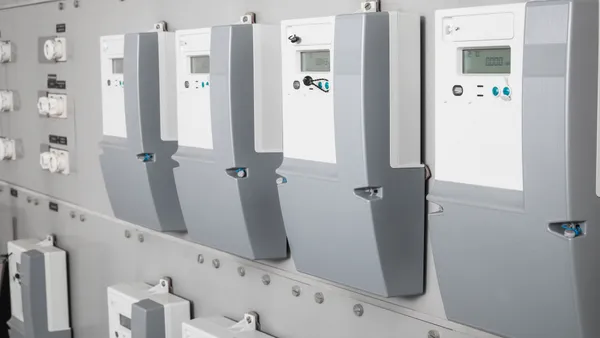Navigant has kicked off the New Year with a fresh style of reports, focused on delivering top-line examinations of disruptive technologies to the utility industry. And with its first of these reports, the energy research firm delved into the potential for utilities to grow so-called "Bring Your Own Thermostat" programs, which leverage customers' growing interest in energy management with utility needs to control their peak demand.
The BYOT model, where customers purchase a device that works with utility and vendor programs to manage usage, has significant growth potential and represents the beginnings of opportunity for utilities, the early stages of a web of connected devices managing energy usage. But it is also somewhat limited – Navigant believes there is the potential for 10% penetration – as price remains a barrier, most programs are in the pilot stage and few customers will rush out to replace their existing devices.
Navigant senior analyst Brett Feldman, who is developing the new series of reports, said he heard a lot about BYOT programs around the conference circuit last year. But while “the chatter has spiked, I don't know about the activity," he said.
“It's going to take a while for utilities to get comfortable,” Feldman said. So far, BYOT programs have mostly been in the pilot phase, and utilities are reluctant to roll out the technology to territories beyond where the initial tests were conducted. “Utilities feel like every territory is different, which is true to some extent. … It's not a simple switch, there are changes and systems that need to be worked out," he said.
“You have to be a little cautious, making sure you have it worked out before you deploy territory-wide,” Feldman said. The worst-case scenario is a demand response program which turns customers off to other utility offerings as well.
According to Navigant, there are roughly 50,000 customers in BYOT demand response programs around the United States today, an estimated $12.5 million market. But looking ahead, the firm believes up to 20 million customers could be involved in these programs, representing a $3 billion market. But while low cost, customer choice and growth in dynamic pricing programs will help the BYOT market grow, the firm also believes "the resulting decrease in utility control and increase in retail competition will require a rethinking of current utility business models and management systems."
The states of things: California and New York
The biggest state for BYOT is probably New York, because as part of the Reforming the Energy Vision strategy, all utilities must offer programs beginning this year.
All of the five utilities operating outside of New York City will need to have dynamic load management programs available by July, and customers can receive incentives for a thermostat and then payments for responding to 80% of the utility's calls to scale back electricity use.
Feldman said California is also delving into the concept, and Southern California Edison and San Diego Gas & Electric have been dipping their toes in for years now. The utilities tapped Alarm.com to aggregate connected devices for the utilities, now being done under the name EnergyHub. That's a strategy that divides many power providers for now, Feldman said.
"A lot of the utilities are just reaching out to the vendor directly," he said. "EnergyHub is trying to be an intermediary."
A steep learning curve
So what s holding back BYOT programs? If most homes have a thermostat, why aren't utilities pushing harder to own a part of it?
Simple: It's really complicated.
"In a traditional demand response program, the utility might select one vendor they're working with," Feldman said. "They can go out and have someone do the installation directly, run the program, the vendor can do the customer service.” But with a program allowing the consumer, not the utility, to take more control over the program it complicates administration.
“You have to determine how many devices you want to work with, which can involve properly pricing devices or incentives," Feldman added. "There are technical and knowledge hurdles. You need some kind of demand response system to communicate with all of the different devices, and hopefully you can just use one system and you don't need individual systems for each device."
Then there is marketing. Utilities must “figure out how to send a consistent message to the marketplace,” said Feldman. You have to track installations, enrollment, incoming information, and coordinate who will supply the service.
“You don't want to confuse the customer so you need to make sure you have a coordinated plan."
And yet, there are benefits...
"You can lower your program costs by not having to pay for thermostats," said Feldman.
The market for energy management devices has been a touchy subject for years. Do customers want them? Do they pay attention?
As power-monitoring equipment gains traction, especially among energy-conscious consumers, analysts expect a range of devices to power the market. Manifest Mind last year predicted the home energy management market to reach an annual value of $2.2 billion in North America by 2022, more than doubling the industry's value.
Utilities will need some time to get comfortable with the BYOT model. It will involve new systems and concepts on both sides of the meter, but ultimately the connected thermostat may become a staple rather than an outlier, and a big part of that is the benefit back to the utility.
"You might do some kind of incentive but it should be lower than fully funding the thermostat," Feldman said. "You don't have to pay for installation. But on the flip side, your control center might feel like they have less ability to monitor devices."
New utility-focused reports
Navigant's new utility focus in its reports reflects some of the remarkable changes happening in the power sector. There is a discomfort as power providers accept new technologies that may reap broader rewards, but involve less control.
The bring your own thermostat research is Navigant's first foray into a new kind of report, which Feldman said is more directed towards utilities. In the past, the firm's offerings have been more focused on the vendor side, looking at market share and global predictions.
“Now, we're starting to turn our attention to the utilities as well, because they have some different goals and drivers,” Feldman said.
The new reports will be more visual, PowerPoint-based, hitting key takeaways at the executive level focusing on disruptive technologies and business models. Future reports will look at solar, storage, the Internet of Things, and more work in the demand response space.






















